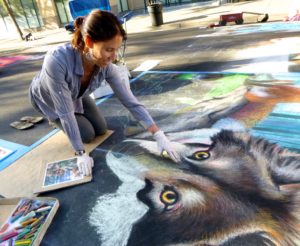Over the years I’ve learned that every beaver festival has a different mood or vibe. Nothing is permanent and everything changes. Some seem full of children, some seem full of impatient parents and some are packed with die-hard martinez beaver defenders. This one seemed thick with passionate naturalists. Many younger and older adults who were drawn by the movie, the book, or the promise of learning more. The adult-heavy crowd meant that fewer children completed the sticker program this year but the ones that did clearly loved it. One child in particular collected all the stickers but patiently kept them because she wanted to put them on herself, carefully, at home.
There were still plenty of children though, fully engaged and eager. Here’s the proof:


I don’t think its possible to over-emphasize how meaningful it was to Amy in the middle creating such a magically wild world. It was a constant reminder to everyone there that in a very real way we are all responsible every day for the nature around us, and for the wilderness we allow underfoot. Once when Suzanne Fouty asked Amy if she minded how temporary all her work was, and how subject to erosion, Amy said that’s actually what she loves about chalk art.
It was a constant reminder to “Live in the moment“.
And what a moment it was! I called our child winners of the raffle yesterday who were so excited to be chosen! 28 children completed the post test and 19 of those got the answers correct. (Many were thrown by the idea that humans were ‘animals’ too.)  Today we’ll send off the beaver puppets as a reward for the winners hard work, Then we can focus on closing out the remaining silent auction items. There are about 25 transactions left to complete.
Today we’ll send off the beaver puppets as a reward for the winners hard work, Then we can focus on closing out the remaining silent auction items. There are about 25 transactions left to complete.
This was one of my favorite parts of the mural. I’m so fond of the ripples made on the water by beaver movements, To my way of thinking they’re kind of like a living dynamic canvas that constantly records his/her movements on the watery medium..
Of course there were other favorite parts. The exciting myriad of bees and ladybugs. The curling and popular snakes. The glorious peregrine and the constantly evolving musicians.
But the famed beaver mobile remains a perennial favorite of young and old alike. My engineer brother in law was fascinated and wanted to know at once how it worked.
There was one last amazing thing that happened on July 30th and it had nothing what so ever to do with Worth A Dam or the beaver festival. Illuminaries artist Tim Hon created this downtown about three blocks away from the park on ferry street. The talented graffiti artist known for his promient Oakland Warriors pieces happens to live in Martinez, and wanted to memorialize the beavers he personally watched with fascination when he moved here.



 Ahh last night was the lovely premiere of Sarah Koenigsberg documentary “Beaver Believers” and many of our Worth A Dam friends were there to see and support. Here is a snap shot Rusty sent of the Q&A session on stage after the film. I recognize Suzanne Fouty, Ben Goldfarb Kevin Swift and Brock Dolman sitting with Sarah on stage. The man asking questions on the right is Steve Dunsky of the Forest Service.
Ahh last night was the lovely premiere of Sarah Koenigsberg documentary “Beaver Believers” and many of our Worth A Dam friends were there to see and support. Here is a snap shot Rusty sent of the Q&A session on stage after the film. I recognize Suzanne Fouty, Ben Goldfarb Kevin Swift and Brock Dolman sitting with Sarah on stage. The man asking questions on the right is Steve Dunsky of the Forest Service.

 musty stink of decomposition wafts into your nostrils. If there’s a fisherman here, he’s thrashing angrily in the willows, his fly caught in a tree.
musty stink of decomposition wafts into your nostrils. If there’s a fisherman here, he’s thrashing angrily in the willows, his fly caught in a tree.

 No more pre-orders. It’s out. I just got a notice from Amazon that its on its way. Hurray!
No more pre-orders. It’s out. I just got a notice from Amazon that its on its way. Hurray! and popular things, from a day-long musical lineup that includes bluegrass and Dixieland bands, a nature-themed silent auction, the return of beaver tours and special activities for children.
and popular things, from a day-long musical lineup that includes bluegrass and Dixieland bands, a nature-themed silent auction, the return of beaver tours and special activities for children.




































